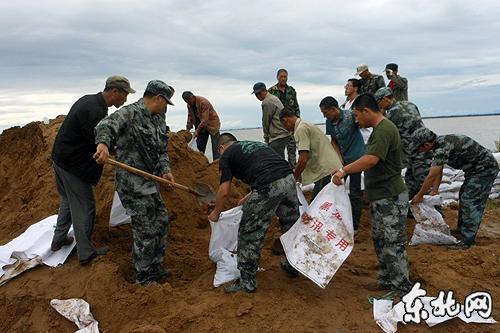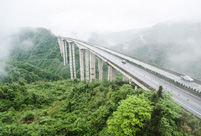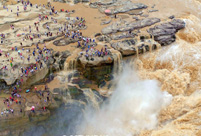


NANCHANG, Aug. 9 -- Wang Lanyu in east China's Jiangxi province still shivers with fear when she recalls that fateful day 18 years ago when the island she lives on flooded.
"My house was totally inundated, the water was about one meter deep," she said. "The flood waters didn't retreat for several months."
Wang lives on Jiangxinzhou island, Jiujiang City. The only way for its more than 50,000 residents to reach or leave the 120-square-kilometer island is by ship.
In 1998, the island's river defence wall was breached, leaving a 300-meter cavity through which thousands of cubic meters of water escaped. The islanders were trapped, and the waterlogged land made the delivery and allocation of disaster-relief resources difficult and dangerous tasks.
Wang said that when she ran out of rice she had no other option but to seek refuge with her parents' in the neighboring province of Anhui.
Like many island residents whose farmland had been destroyed, her husband had seek employment as a migrant worker elsewhere in China.
After the disaster, the local government began a long and arduous project to reinforce the defence wall.
"During the past decade, we haven't see such a severe breach again," said Xu Chunyao, Communist Party of China chief of Jiujiang.
In April, irregular crevices were discovered in the defence wall. The central and local government allocated more than 30 million yuan to cover the repair work.
Jiujiang's story is not an isolated case. Drawing on the lessons learned in 1998, when the El Nino effect caused detrimental flooding across China, and was linked to more than 1,320 deaths, China had had no choice but to overhaul its flood control techniques.
"The main cause for the disaster was poor water management," said Zhang Mingguang, vice head of the planning bureau under the Yangtze River Water Resources Committee.
In the central province of Hubei alone, 4,974 sites were deemed hazardous in 1998, including 34 breaches.
China's management and exploitation of its water resource spans millennia. The first embankment along the Yangtze River broke ground some 2,000 years ago, more recently, however, a large-scale embankment project started in 1998. More than 6.5 billion yuan has been spent on 28 embankment projects in Hubei, Hunan, Anhui and Jiangxi, which all began in 1999. To date, the project has built 1,935 kilometers of embankment.
The question of what to do with the excess water was another issue.
According to Shen Huazhong with Yangtze River Water Resources Committee, 42 flood storage areas are located along the middle and lower reaches of the river, which can hold up to 59 billion cubic meters of water.
Better forecasting also helped.
Xu Shaojun, vice director with the flood control and drought relief authority in Hubei, recalled that in 1998, weather forecasts and information on floods were disseminated by telegraph.
"They sent three telegraphs a day, at 8 a.m., 2 p.m. and 8 p.m.," he said. "They measured the water level by sight."
While forecasting and communication have come along way, problems remain.
Severe flooding across the country has left hundreds dead or missing since early June, and the way in which these fatal floods were handled made it clear that many challenges remain.
"In some smaller lakes and rivers, flood-prevention measures were ineffective," said Zheng Shouren, a fellow with the Chinese Academy of Engineering. "Moreover, management appeared to be also a problem."
In Jiujiang, constant vigilance is needed.
"The shoreline is long and there was no one with a complete overview of the potential risks," said Xu Chunyao.
The floods this year are on par with those seen in 1998. Luckily, along some tributaries of the Yangtze if it had not been for the local community the situation could have been much, much worse.
Following days and days of rain last month, more than 3,000 migrant workers returned to their hometowns to help with flood control and management, including Wang's husband.
The family's new house is on the northern embankment of Jiangxinzhou, this time round when the floods came, the water was well below the window.
"The embankment is much stronger now," Wang said. "The water is retreating and the level is dropping. Jiangxinzhou stood the test."
 Spectacular bridge with one of the tallest piers in the world
Spectacular bridge with one of the tallest piers in the world Magnificent view of Hukou Waterfall
Magnificent view of Hukou Waterfall A glimpse of Stride 2016 Zhurihe B military drill
A glimpse of Stride 2016 Zhurihe B military drill US Navy chief tours Liaoning aircraft carrier
US Navy chief tours Liaoning aircraft carrier Chinese American woman wins Miss Michigan
Chinese American woman wins Miss Michigan Centenarian couple takes first wedding photos
Centenarian couple takes first wedding photos Traditional Tibetan costumes presented during fashion show
Traditional Tibetan costumes presented during fashion show How did ancient people escape the summer heat
How did ancient people escape the summer heat Breathtaking scenery of Hulun Buir grassland
Breathtaking scenery of Hulun Buir grassland Top 10 livable Chinese cities
Top 10 livable Chinese cities Top 20 hottest women in the world in 2014
Top 20 hottest women in the world in 2014 Top 10 hardest languages to learn
Top 10 hardest languages to learn China’s Top 10 Unique Bridges, Highways and Roads
China’s Top 10 Unique Bridges, Highways and Roads Returnee resources
Returnee resources Smug Aussie swimmer won’t cloud Rio
Smug Aussie swimmer won’t cloud Rio Jade and redwood traders in China face challenges
Jade and redwood traders in China face challenges  Censorship a hurdle for tomb raiding book adaptations
Censorship a hurdle for tomb raiding book adaptations Day|Week